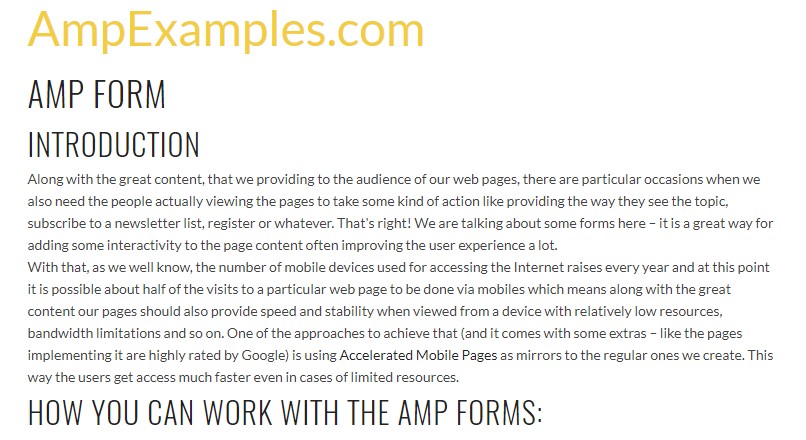Bootstrap Form Elements
Intro
Bootstrap provides various form control designs, layout options, along with custom components for generating a vast range of Bootstrap Form Example.
Forms offer the ideal resolution for having several suggestions directly from the visitors of our web pages. On the occasion that it's a plain touch or perhaps subscription form including just a only a few areas or else a sophisticated and properly thought examination the Bootstrap 4 structure got all the things that is definitely really needed to execute the job and get great responsive visual appeal.
By default inside the Bootstrap framework the form components are styled to span the whole width of its parent element-- this stuff becomes reached by committing the .form-control class. The directions and lebels ought to be wrapped in a parent element with the .form-group class for ideal spacing.
Bootstrap Form Group commands
Bootstrap's form commands expand upon our Rebooted form designs along with classes.
Make use of these classes to opt into their modified displays to get a more steady rendering around browsers and gadgets . The example form below demonstrates common HTML form features which get improved styles coming from Bootstrap plus extra classes.
Take note, due to the fact that Bootstrap uses the HTML5 doctype, all of the inputs must provide a type attribute.
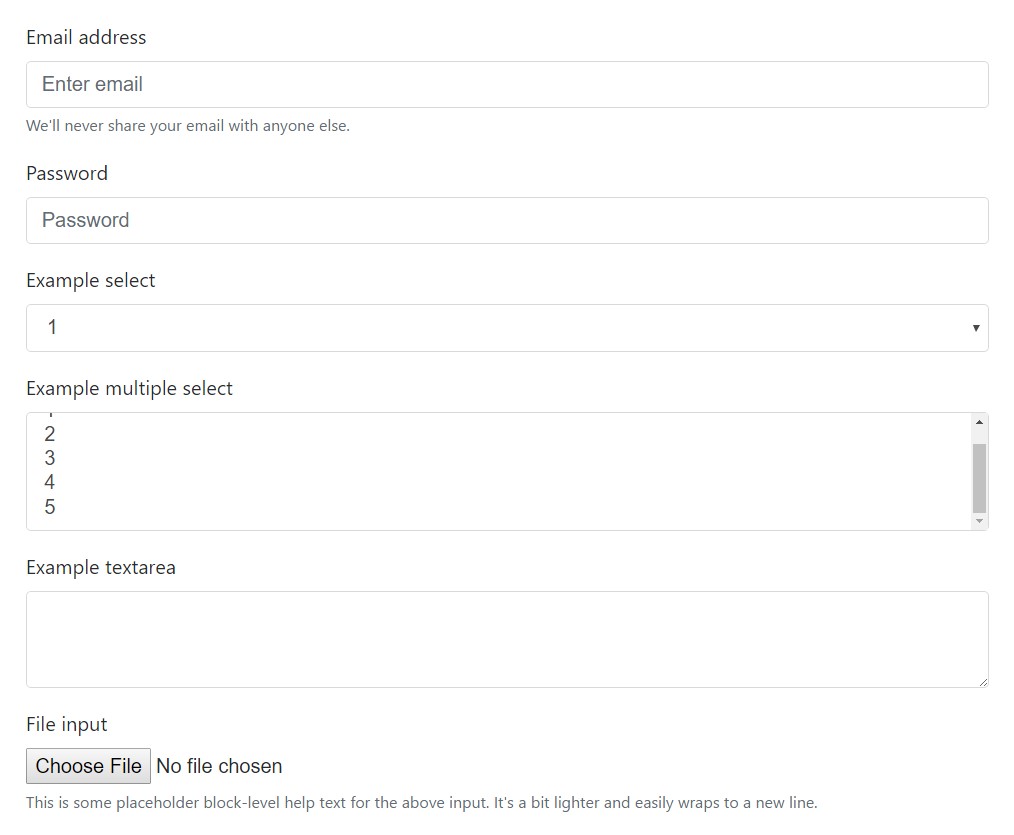

<form>
<div class="form-group">
<label for="exampleInputEmail1">Email address</label>
<input type="email" class="form-control" id="exampleInputEmail1" aria-describedby="emailHelp" placeholder="Enter email">
<small id="emailHelp" class="form-text text-muted">We'll never share your email with anyone else.</small>
</div>
<div class="form-group">
<label for="exampleInputPassword1">Password</label>
<input type="password" class="form-control" id="exampleInputPassword1" placeholder="Password">
</div>
<div class="form-group">
<label for="exampleSelect1">Example select</label>
<select class="form-control" id="exampleSelect1">
<option>1</option>
<option>2</option>
<option>3</option>
<option>4</option>
<option>5</option>
</select>
</div>
<div class="form-group">
<label for="exampleSelect2">Example multiple select</label>
<select multiple class="form-control" id="exampleSelect2">
<option>1</option>
<option>2</option>
<option>3</option>
<option>4</option>
<option>5</option>
</select>
</div>
<div class="form-group">
<label for="exampleTextarea">Example textarea</label>
<textarea class="form-control" id="exampleTextarea" rows="3"></textarea>
</div>
<div class="form-group">
<label for="exampleInputFile">File input</label>
<input type="file" class="form-control-file" id="exampleInputFile" aria-describedby="fileHelp">
<small id="fileHelp" class="form-text text-muted">This is some placeholder block-level help text for the above input. It's a bit lighter and easily wraps to a new line.</small>
</div>
<fieldset class="form-group">
<legend>Radio buttons</legend>
<div class="form-check">
<label class="form-check-label">
<input type="radio" class="form-check-input" name="optionsRadios" id="optionsRadios1" value="option1" checked>
Option one is this and that—be sure to include why it's great
</label>
</div>
<div class="form-check">
<label class="form-check-label">
<input type="radio" class="form-check-input" name="optionsRadios" id="optionsRadios2" value="option2">
Option two can be something else and selecting it will deselect option one
</label>
</div>
<div class="form-check disabled">
<label class="form-check-label">
<input type="radio" class="form-check-input" name="optionsRadios" id="optionsRadios3" value="option3" disabled>
Option three is disabled
</label>
</div>
</fieldset>
<div class="form-check">
<label class="form-check-label">
<input type="checkbox" class="form-check-input">
Check me out
</label>
</div>
<button type="submit" class="btn btn-primary">Submit</button>
</form>Below is a full selection of the specific Bootstrap Form Field commands sustained by Bootstrap together with the classes which modify them. Added information is accessible for every group.
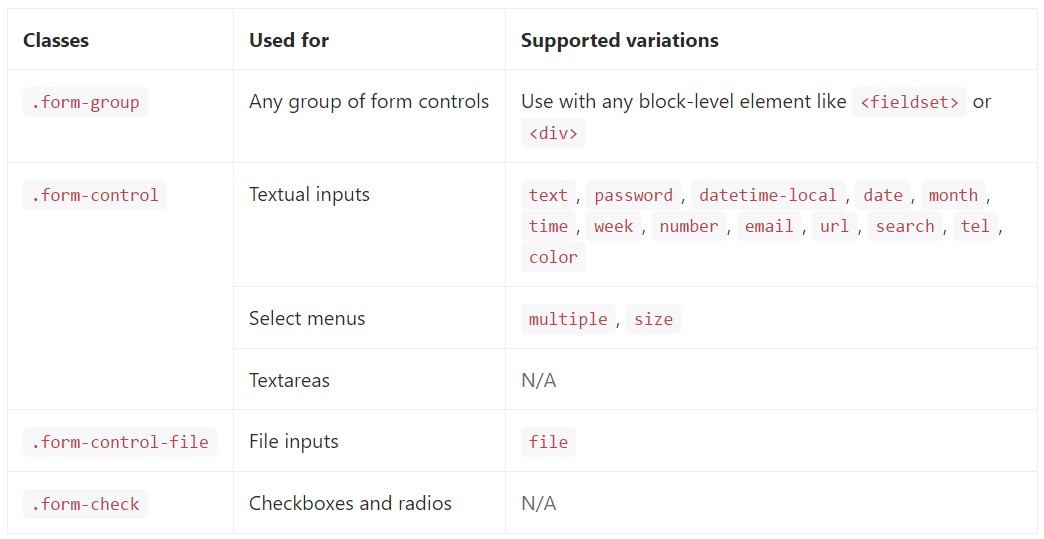
Textual inputs
Here are the good examples of .form-control applied to each and every textual HTML5 <input> type.
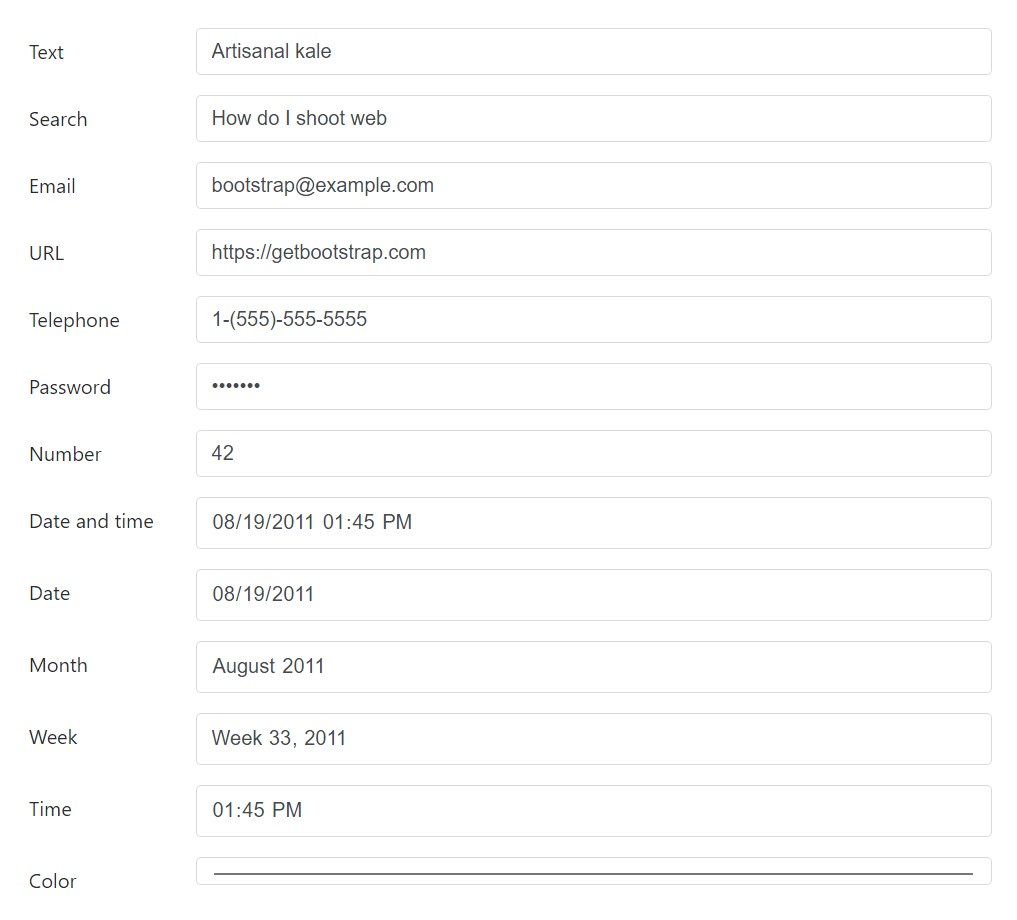
<div class="form-group row">
<label for="example-text-input" class="col-2 col-form-label">Text</label>
<div class="col-10">
<input class="form-control" type="text" value="Artisanal kale" id="example-text-input">
</div>
</div>
<div class="form-group row">
<label for="example-search-input" class="col-2 col-form-label">Search</label>
<div class="col-10">
<input class="form-control" type="search" value="How do I shoot web" id="example-search-input">
</div>
</div>
<div class="form-group row">
<label for="example-email-input" class="col-2 col-form-label">Email</label>
<div class="col-10">
<input class="form-control" type="email" value="[email protected]" id="example-email-input">
</div>
</div>
<div class="form-group row">
<label for="example-url-input" class="col-2 col-form-label">URL</label>
<div class="col-10">
<input class="form-control" type="url" value="https://getbootstrap.com" id="example-url-input">
</div>
</div>
<div class="form-group row">
<label for="example-tel-input" class="col-2 col-form-label">Telephone</label>
<div class="col-10">
<input class="form-control" type="tel" value="1-(555)-555-5555" id="example-tel-input">
</div>
</div>
<div class="form-group row">
<label for="example-password-input" class="col-2 col-form-label">Password</label>
<div class="col-10">
<input class="form-control" type="password" value="hunter2" id="example-password-input">
</div>
</div>
<div class="form-group row">
<label for="example-number-input" class="col-2 col-form-label">Number</label>
<div class="col-10">
<input class="form-control" type="number" value="42" id="example-number-input">
</div>
</div>
<div class="form-group row">
<label for="example-datetime-local-input" class="col-2 col-form-label">Date and time</label>
<div class="col-10">
<input class="form-control" type="datetime-local" value="2011-08-19T13:45:00" id="example-datetime-local-input">
</div>
</div>
<div class="form-group row">
<label for="example-date-input" class="col-2 col-form-label">Date</label>
<div class="col-10">
<input class="form-control" type="date" value="2011-08-19" id="example-date-input">
</div>
</div>
<div class="form-group row">
<label for="example-month-input" class="col-2 col-form-label">Month</label>
<div class="col-10">
<input class="form-control" type="month" value="2011-08" id="example-month-input">
</div>
</div>
<div class="form-group row">
<label for="example-week-input" class="col-2 col-form-label">Week</label>
<div class="col-10">
<input class="form-control" type="week" value="2011-W33" id="example-week-input">
</div>
</div>
<div class="form-group row">
<label for="example-time-input" class="col-2 col-form-label">Time</label>
<div class="col-10">
<input class="form-control" type="time" value="13:45:00" id="example-time-input">
</div>
</div>
<div class="form-group row">
<label for="example-color-input" class="col-2 col-form-label">Color</label>
<div class="col-10">
<input class="form-control" type="color" value="#563d7c" id="example-color-input">
</div>
</div>Form arrangements
As Bootstrap uses display: block and width :100% to main part our form controls, forms will likely by default stack vertically. More classes may possibly be applied to change this specific layout on a per-form basis.
Form groups
The .form-group class is the simplest procedure to add in fascinating structure to forms. Its main function is to present margin-bottom about a label and control coupling. As a bonus, since it's a class you can certainly make use of it along with <fieldset>-s, <div>-s, or almost any other feature.

<form>
<div class="form-group">
<label for="formGroupExampleInput">Example label</label>
<input type="text" class="form-control" id="formGroupExampleInput" placeholder="Example input">
</div>
<div class="form-group">
<label for="formGroupExampleInput2">Another label</label>
<input type="text" class="form-control" id="formGroupExampleInput2" placeholder="Another input">
</div>
</form>Inline forms
Employ the .form-inline class to feature a variety of labels, form regulations , and also switches upon a singular horizontal row. Form controls inside of inline forms can be different a little from their default status.
- Controls are display: flex, breaking any sort of HTML white-colored area and letting you to present alignment regulation including spacing and flexbox utilities.
- Controls plus input groups get width: auto to bypass the Bootstrap default width: 100%.
- Controls exclusively show up inline within viewports which are at least 576px big to represent narrow viewports on mobile devices.
You may perhaps need to personally manage the width and alignment of specific form controls plus spacing utilities (as shown below) Lastly, don't forget to regularly provide a <label> along with each form control, whether or not you must conceal it directly from non-screenreader website visitors with a code.

<form class="form-inline">
<label class="sr-only" for="inlineFormInput">Name</label>
<input type="text" class="form-control mb-2 mr-sm-2 mb-sm-0" id="inlineFormInput" placeholder="Jane Doe">
<label class="sr-only" for="inlineFormInputGroup">Username</label>
<div class="input-group mb-2 mr-sm-2 mb-sm-0">
<div class="input-group-addon">@</div>
<input type="text" class="form-control" id="inlineFormInputGroup" placeholder="Username">
</div>
<div class="form-check mb-2 mr-sm-2 mb-sm-0">
<label class="form-check-label">
<input class="form-check-input" type="checkbox"> Remember me
</label>
</div>
<button type="submit" class="btn btn-primary">Submit</button>
</form>Custom made form controls as well as chooses are additionally supported.

<form class="form-inline">
<label class="mr-sm-2" for="inlineFormCustomSelect">Preference</label>
<select class="custom-select mb-2 mr-sm-2 mb-sm-0" id="inlineFormCustomSelect">
<option selected>Choose...</option>
<option value="1">One</option>
<option value="2">Two</option>
<option value="3">Three</option>
</select>
<label class="custom-control custom-checkbox mb-2 mr-sm-2 mb-sm-0">
<input type="checkbox" class="custom-control-input">
<span class="custom-control-indicator"></span>
<span class="custom-control-description">Remember my preference</span>
</label>
<button type="submit" class="btn btn-primary">Submit</button>
</form>Alternatives to concealed labels
Assistive technological innovations for example, screen readers will certainly have issue along with your forms if you don't incorporate a label for each input. For these inline forms, you have the ability to cover up the labels employing the .sr-only class. There are more different options of providing a label for assistive technological innovations, for example, the aria-label, aria-labelledby or title attribute. If not any of these are present, assistive technologies can invoke applying the placeholder attribute, in the case that present, and yet note that application of placeholder considering that a replacing for other labelling approaches is not advised.
Working with the Grid
For extra organised form layouts which are additionally responsive, you can surely apply Bootstrap's predefined grid classes alternatively mixins to produce horizontal forms. Include the .row class to form groups and utilize the .col-*-* classes to define the width of your labels and controls.
Be sure to add .col-form-label to your <label>-s as well so they’re vertically centered with their associated form controls. For <legend> elements, you can use .col-form-legend to make them appear similar to regular <label> elements.
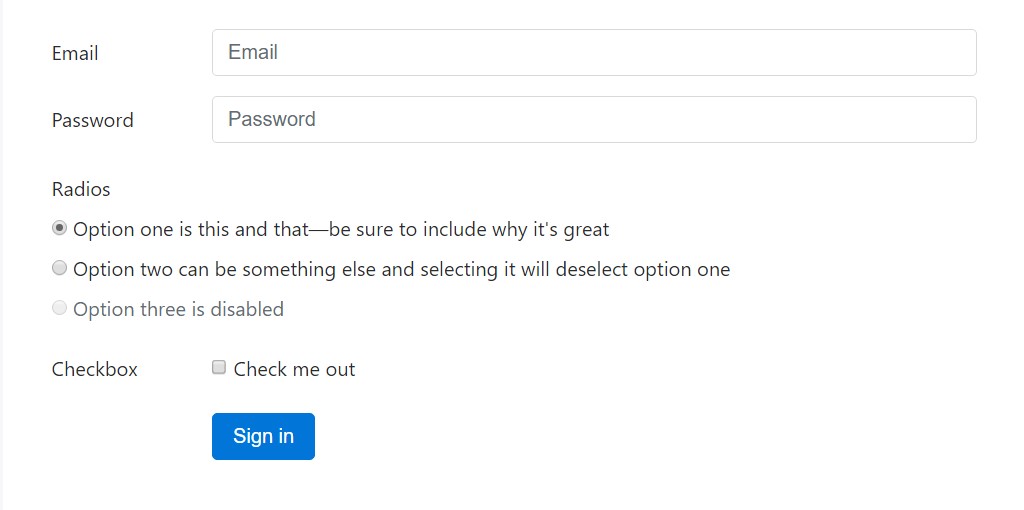
<div class="container">
<form>
<div class="form-group row">
<label for="inputEmail3" class="col-sm-2 col-form-label">Email</label>
<div class="col-sm-10">
<input type="email" class="form-control" id="inputEmail3" placeholder="Email">
</div>
</div>
<div class="form-group row">
<label for="inputPassword3" class="col-sm-2 col-form-label">Password</label>
<div class="col-sm-10">
<input type="password" class="form-control" id="inputPassword3" placeholder="Password">
</div>
</div>
<fieldset class="form-group row">
<legend class="col-form-legend col-sm-2">Radios</legend>
<div class="col-sm-10">
<div class="form-check">
<label class="form-check-label">
<input class="form-check-input" type="radio" name="gridRadios" id="gridRadios1" value="option1" checked>
Option one is this and that—be sure to include why it's great
</label>
</div>
<div class="form-check">
<label class="form-check-label">
<input class="form-check-input" type="radio" name="gridRadios" id="gridRadios2" value="option2">
Option two can be something else and selecting it will deselect option one
</label>
</div>
<div class="form-check disabled">
<label class="form-check-label">
<input class="form-check-input" type="radio" name="gridRadios" id="gridRadios3" value="option3" disabled>
Option three is disabled
</label>
</div>
</div>
</fieldset>
<div class="form-group row">
<label class="col-sm-2">Checkbox</label>
<div class="col-sm-10">
<div class="form-check">
<label class="form-check-label">
<input class="form-check-input" type="checkbox"> Check me out
</label>
</div>
</div>
</div>
<div class="form-group row">
<div class="offset-sm-2 col-sm-10">
<button type="submit" class="btn btn-primary">Sign in</button>
</div>
</div>
</form>
</div>Grid-based form design and styles additionally support small-sized and large inputs.

<div class="container">
<form>
<div class="form-group row">
<label for="lgFormGroupInput" class="col-sm-2 col-form-label col-form-label-lg">Email</label>
<div class="col-sm-10">
<input type="email" class="form-control form-control-lg" id="lgFormGroupInput" placeholder="[email protected]">
</div>
</div>
<div class="form-group row">
<label for="smFormGroupInput" class="col-sm-2 col-form-label col-form-label-sm">Email</label>
<div class="col-sm-10">
<input type="email" class="form-control form-control-sm" id="smFormGroupInput" placeholder="[email protected]">
</div>
</div>
</form>
</div>Checkboxes and radios
Default checkboxes and radios are raised upon with the support of .form-check, a specific class for both of these input types that improves the layout and actions of their HTML features. Checkboxes are for selecting one or a couple of options inside a selection, at the same time radios are for choosing one capability from several.
Disabled checkboxes and radios are maintained, but to give a not-allowed pointer on hover of the parent <label>, you'll need to bring in the .disabled class to the parent .form-check. The disabled class is going to also make lighter the text coloration to help reveal the input's state.
Each checkbox and radio is wrapped inside a <label> for three good reasons:
- It gives a bigger hit areas for checking the control.
- It offers a valuable and semantic wrapper to help us replace the default <input>-s.
- It produces the state of the <input> automatically, showing no JavaScript is needed.
We cover up the default <input> with opacity and use the .custom-control-indicator to construct a new custom-made form indicator in its place. Unfortunately we can't develop a custom-made one from just the <input> considering that CSS's content doesn't work on that component..
We employ the sibling selector (~) for all of our <input> states-- just like : checked-- to correctly design our customized form indication . When incorporated along with the .custom-control-description class, we have the ability to additionally design the text for every item built on the <input>-s state.
In the checked states, we use base64 embedded SVG icons from Open Iconic. This provides us the best control for styling and positioning across browsers and devices.
Checkboxes

<label class="custom-control custom-checkbox">
<input type="checkbox" class="custom-control-input">
<span class="custom-control-indicator"></span>
<span class="custom-control-description">Check this custom checkbox</span>
</label>Customized checkboxes can also apply the : indeterminate pseudo class when manually specified via JavaScript (there is certainly no accessible HTML attribute for indicating it).

In the case that you are actually utilizing jQuery, something such as this should really be good enough:
$('.your-checkbox').prop('indeterminate', true)Radios

<label class="custom-control custom-radio">
<input id="radio1" name="radio" type="radio" class="custom-control-input">
<span class="custom-control-indicator"></span>
<span class="custom-control-description">Toggle this custom radio</span>
</label>
<label class="custom-control custom-radio">
<input id="radio2" name="radio" type="radio" class="custom-control-input">
<span class="custom-control-indicator"></span>
<span class="custom-control-description">Or toggle this other custom radio</span>
</label>Default (stacked)
By default, any variety of checkboxes and radios which are certainly close sibling will be vertically loaded and effectively spaced using .form-check.

<div class="form-check">
<label class="form-check-label">
<input class="form-check-input" type="checkbox" value="">
Option one is this and that—be sure to include why it's great
</label>
</div>
<div class="form-check disabled">
<label class="form-check-label">
<input class="form-check-input" type="checkbox" value="" disabled>
Option two is disabled
</label>
</div>
<div class="form-check">
<label class="form-check-label">
<input class="form-check-input" type="radio" name="exampleRadios" id="exampleRadios1" value="option1" checked>
Option one is this and that—be sure to include why it's great
</label>
</div>
<div class="form-check">
<label class="form-check-label">
<input class="form-check-input" type="radio" name="exampleRadios" id="exampleRadios2" value="option2">
Option two can be something else and selecting it will deselect option one
</label>
</div>
<div class="form-check disabled">
<label class="form-check-label">
<input class="form-check-input" type="radio" name="exampleRadios" id="exampleRadios3" value="option3" disabled>
Option three is disabled
</label>
</div>Inline
Group checkboxes or else radios on the exact same horizontal row by providing .form-check-inline to every .form-check.

<div class="form-check form-check-inline">
<label class="form-check-label">
<input class="form-check-input" type="checkbox" id="inlineCheckbox1" value="option1"> 1
</label>
</div>
<div class="form-check form-check-inline">
<label class="form-check-label">
<input class="form-check-input" type="checkbox" id="inlineCheckbox2" value="option2"> 2
</label>
</div>
<div class="form-check form-check-inline disabled">
<label class="form-check-label">
<input class="form-check-input" type="checkbox" id="inlineCheckbox3" value="option3" disabled> 3
</label>
</div>
<div class="form-check form-check-inline">
<label class="form-check-label">
<input class="form-check-input" type="radio" name="inlineRadioOptions" id="inlineRadio1" value="option1"> 1
</label>
</div>
<div class="form-check form-check-inline">
<label class="form-check-label">
<input class="form-check-input" type="radio" name="inlineRadioOptions" id="inlineRadio2" value="option2"> 2
</label>
</div>
<div class="form-check form-check-inline disabled">
<label class="form-check-label">
<input class="form-check-input" type="radio" name="inlineRadioOptions" id="inlineRadio3" value="option3" disabled> 3
</label>
</div>Free from labels
You should not provide a text within the <label>, the input is positioned as you would definitely expect. Currently strictly works with non-inline checkboxes and radios. Remember to currently provide some kind of label for assistive systems (for instance, using aria-label).

<div class="form-check">
<label class="form-check-label">
<input class="form-check-input" type="checkbox" id="blankCheckbox" value="option1" aria-label="...">
</label>
</div>
<div class="form-check">
<label class="form-check-label">
<input class="form-check-input" type="radio" name="blankRadio" id="blankRadio1" value="option1" aria-label="...">
</label>
</div>Static controls
In cases where you ought to put plain text next to a form label within a form, employ the .form-control-static class on an element of your choice.

<form>
<div class="form-group row">
<label class="col-sm-2 col-form-label">Email</label>
<div class="col-sm-10">
<p class="form-control-static">[email protected]</p>
</div>
</div>
<div class="form-group row">
<label for="inputPassword" class="col-sm-2 col-form-label">Password</label>
<div class="col-sm-10">
<input type="password" class="form-control" id="inputPassword" placeholder="Password">
</div>
</div>
</form>
<form class="form-inline">
<div class="form-group">
<label class="sr-only">Email</label>
<p class="form-control-static">[email protected]</p>
</div>
<div class="form-group mx-sm-3">
<label for="inputPassword2" class="sr-only">Password</label>
<input type="password" class="form-control" id="inputPassword2" placeholder="Password">
</div>
<button type="submit" class="btn btn-primary">Confirm identity</button>
</form>Disabled forms
Bring in the disabled boolean attribute on an input to avoid user interactions. Disabled inputs show up lighter plus bring in a not-allowed pointer.
<input class="form-control" id="disabledInput" type="text" placeholder="Disabled input here..." disabled>Add in the disabled attribute to a <fieldset> to turn off all the controls within.
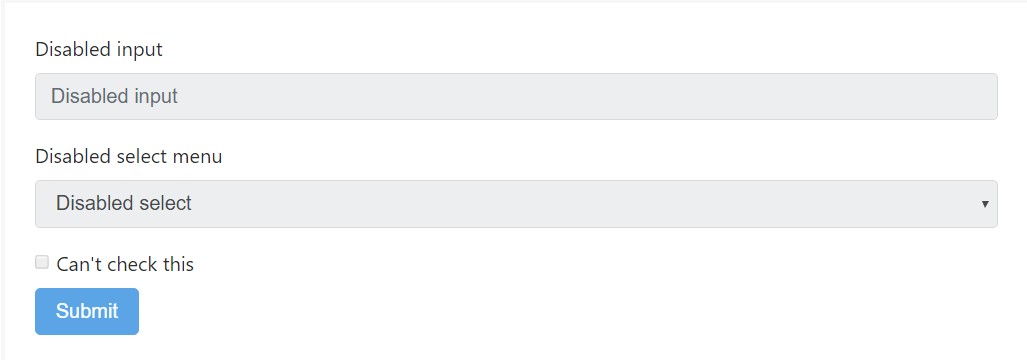
<form>
<fieldset disabled>
<div class="form-group">
<label for="disabledTextInput">Disabled input</label>
<input type="text" id="disabledTextInput" class="form-control" placeholder="Disabled input">
</div>
<div class="form-group">
<label for="disabledSelect">Disabled select menu</label>
<select id="disabledSelect" class="form-control">
<option>Disabled select</option>
</select>
</div>
<div class="checkbox">
<label>
<input type="checkbox"> Can't check this
</label>
</div>
<button type="submit" class="btn btn-primary">Submit</button>
</fieldset>
</form> Caution about hyperlink functions of <a>
By default, internet browsers are going to handle all native form controls (<input>, <select> and <button> elements) inside a <fieldset disabled> as disabled, evading each of the keyboard and computer mouse interplays on them. However, if your form also provides <a ... class="btn btn-*"> components, these are going to just be brought a look of pointer-events: none. Like noted in the section about disabled state for buttons (and esspecially in the sub-section for anchor components ), this specific CSS feature is not actually yet standardized and also isn't actually completely promoted in Opera 18 and below, or in Internet Explorer 11, and will not prevent keyboard users from having the capacity to direct or else turn on such urls. And so to get safer, use customized JavaScript to disable this sort of hyperlinks.
Cross-browser congruity
Though Bootstrap is going to utilize these particular varieties in all internet browsers, Internet Explorer 11 and below do not totally support the disabled attribute on a <fieldset>. Work with custom made JavaScript to disable the fieldset in these browsers.
Readonly inputs
Provide the readonly boolean attribute upon an input to avoid customization of the input's value. Read-only inputs show up lighter (just like disabled inputs), but keep the standard pointer.

<input class="form-control" type="text" placeholder="Readonly input here…" readonly>Command sizing
Establish heights working with classes like .form-control-lg, plus put widths utilizing grid column classes such as .col-lg-*.

<input class="form-control form-control-lg" type="text" placeholder=".form-control-lg">
<input class="form-control" type="text" placeholder="Default input">
<input class="form-control form-control-sm" type="text" placeholder=".form-control-sm">
<select class="form-control form-control-lg">
<option>Large select</option>
</select>
<select class="form-control">
<option>Default select</option>
</select>
<select class="form-control form-control-sm">
<option>Small select</option>
</select>Column sizing
Wrap inputs in a grid columns, or else any customized parent feature, to easily execute the desired widths.

<div class="row">
<div class="col-2">
<input type="text" class="form-control" placeholder=".col-2">
</div>
<div class="col-3">
<input type="text" class="form-control" placeholder=".col-3">
</div>
<div class="col-4">
<input type="text" class="form-control" placeholder=".col-4">
</div>
</div>Assist content
The .help-block class happens to be dismissed within the brand new version. If you ought to apply some supplemental text message in order to help your site visitors to better get around - employ the .form-text class alternatively. Bootstrap 4 has amazing construction within validation styles for the form controls being applied . In this particular version the .has-feedback class has been simply dropped-- it's no more needed together with the introduction of the .form-control-danger, .form-control-warning and .form-control-success classes adding a small-sized info icon straight in the input areas.
Relating assistance message along with form controls
Assistance message needs to be clearly related to the form control it associates with working with the aria-describedby attribute. This will certainly make certain that the assistive technologies-- for instance, screen readers-- will declare this help text message if the user focuses or else enters the control.
Block level
Block support text message-- for below inputs or else for extended words of the assistance content-- can be simply accomplished utilizing .form-text. This class consists of display: block and brings in a bit of top margin for quick spacing from the inputs mentioned earlier.

<label for="inputPassword5">Password</label>
<input type="password" id="inputPassword5" class="form-control" aria-describedby="passwordHelpBlock">
<p id="passwordHelpBlock" class="form-text text-muted">
Your password must be 8-20 characters long, contain letters and numbers, and must not contain spaces, special characters, or emoji.
</p>Inline
Inline text message have the ability to utilize any kind of usual inline HTML element (be it a , <span>, or else something else).

<form class="form-inline">
<div class="form-group">
<label for="inputPassword4">Password</label>
<input type="password" id="inputPassword4" class="form-control mx-sm-3" aria-describedby="passwordHelpInline">
<small id="passwordHelpInline" class="text-muted">
Must be 8-20 characters long.
</small>
</div>
</form>Validation
Bootstrap consists of validation styles for success, warning, and danger states on most form controls.
The way to operate
Here's a briefing of ways they do the job:
- To utilize, incorporate .has-warning, .has-danger, or .has-success to the parent feature. Any .col-form-label, .form-control, as well as custom made form component will be given the validation styles.
- Contextual validation text message, as well as your usual form area guidance words, may possibly be added together with the application of .form-control-feedback. This content is going to adapt to the parent .has-* class. By default it simply utilizes a little bit of margin for spacing and also a transformed color for every state.
- Validation icons are url()-s set up through Sass variables which are related to background-image statements for each and every state.
- You may use your personal base64 PNGs or SVGs by updating the Sass variables plus recompiling.
- Icons can easily likewise be disabled totally through establishing the variables to none as well as commenting out the source Sass.
Identifying forms
Commonly saying, you'll need to utilize a particular state for certain styles of responses:
- Danger is outstanding for the moment there's a blocking or demanded field. A user must notify this field properly to submit the form.
- Warning works effectively for input values that are in development, such as password strength, as well as soft validation right before a user tries to submit a form.
- And as a final point, success is ideal for situations each time you have per-field validation through a form and also would like to urge a user through the whole fields.
Some examples
Here are some cases of the previously mentioned classes at work. First up is your usual left-aligned fields along with labels, guidance text message, and validation message.
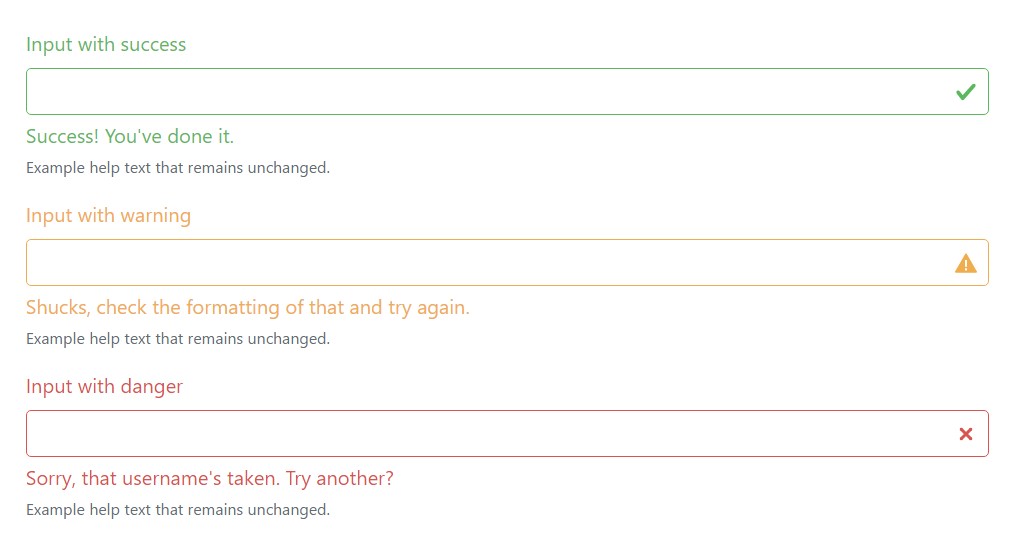
<div class="form-group has-success">
<label class="form-control-label" for="inputSuccess1">Input with success</label>
<input type="text" class="form-control form-control-success" id="inputSuccess1">
<div class="form-control-feedback">Success! You've done it.</div>
<small class="form-text text-muted">Example help text that remains unchanged.</small>
</div>
<div class="form-group has-warning">
<label class="form-control-label" for="inputWarning1">Input with warning</label>
<input type="text" class="form-control form-control-warning" id="inputWarning1">
<div class="form-control-feedback">Shucks, check the formatting of that and try again.</div>
<small class="form-text text-muted">Example help text that remains unchanged.</small>
</div>
<div class="form-group has-danger">
<label class="form-control-label" for="inputDanger1">Input with danger</label>
<input type="text" class="form-control form-control-danger" id="inputDanger1">
<div class="form-control-feedback">Sorry, that username's taken. Try another?</div>
<small class="form-text text-muted">Example help text that remains unchanged.</small>
</div>Those similar states have the ability to additionally be used along with horizontal forms.
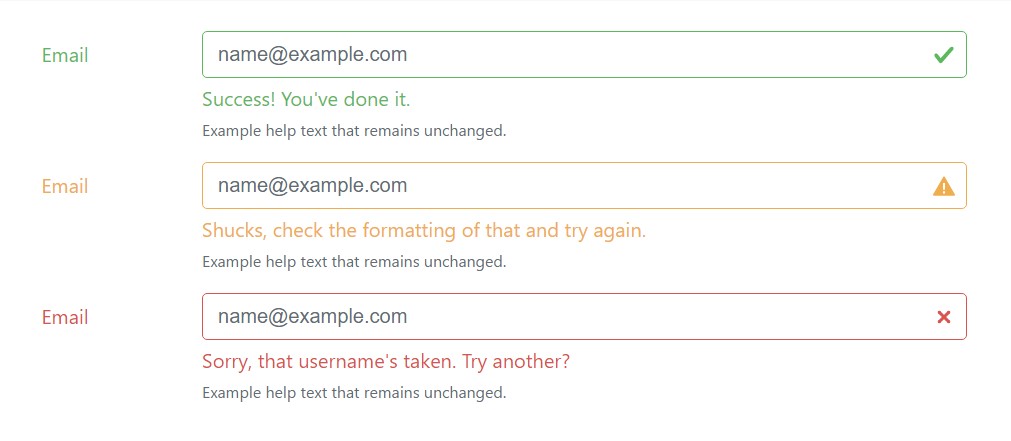
<div class="container">
<form>
<div class="form-group row has-success">
<label for="inputHorizontalSuccess" class="col-sm-2 col-form-label">Email</label>
<div class="col-sm-10">
<input type="email" class="form-control form-control-success" id="inputHorizontalSuccess" placeholder="[email protected]">
<div class="form-control-feedback">Success! You've done it.</div>
<small class="form-text text-muted">Example help text that remains unchanged.</small>
</div>
</div>
<div class="form-group row has-warning">
<label for="inputHorizontalWarning" class="col-sm-2 col-form-label">Email</label>
<div class="col-sm-10">
<input type="email" class="form-control form-control-warning" id="inputHorizontalWarning" placeholder="[email protected]">
<div class="form-control-feedback">Shucks, check the formatting of that and try again.</div>
<small class="form-text text-muted">Example help text that remains unchanged.</small>
</div>
</div>
<div class="form-group row has-danger">
<label for="inputHorizontalDnger" class="col-sm-2 col-form-label">Email</label>
<div class="col-sm-10">
<input type="email" class="form-control form-control-danger" id="inputHorizontalDnger" placeholder="[email protected]">
<div class="form-control-feedback">Sorry, that username's taken. Try another?</div>
<small class="form-text text-muted">Example help text that remains unchanged.</small>
</div>
</div>
</form>
</div>Radios and checkboxes are also maintained.

<div class="form-check has-success">
<label class="form-check-label">
<input type="checkbox" class="form-check-input" id="checkboxSuccess" value="option1">
Checkbox with success
</label>
</div>
<div class="form-check has-warning">
<label class="form-check-label">
<input type="checkbox" class="form-check-input" id="checkboxWarning" value="option1">
Checkbox with warning
</label>
</div>
<div class="form-check has-danger">
<label class="form-check-label">
<input type="checkbox" class="form-check-input" id="checkboxDanger" value="option1">
Checkbox with danger
</label>
</div>Custom-made forms
For a lot more customization and cross browser consistency, utilize Bootstrap absolutely custom-made form elements to substitute the web browser defaults. They're constructed on very top of accessible and semantic markup, so they are definitely stable substitutes for any type of default form control.
Disabled
Custom-made radios and checkboxes are able to also be disabled . Bring in the disabled boolean attribute to the <input> and the custom-made indicator and also label information will be automatically designated.

<label class="custom-control custom-checkbox">
<input type="checkbox" class="custom-control-input" disabled>
<span class="custom-control-indicator"></span>
<span class="custom-control-description">Check this custom checkbox</span>
</label>
<label class="custom-control custom-radio">
<input id="radio3" name="radioDisabled" type="radio" class="custom-control-input" disabled>
<span class="custom-control-indicator"></span>
<span class="custom-control-description">Toggle this custom radio</span>
</label>Validation states
Incorporate the other states to your customized forms along with Bootstrap validation classes.

<div class="form-group has-success">
<label class="custom-control custom-checkbox">
<input type="checkbox" class="custom-control-input">
<span class="custom-control-indicator"></span>
<span class="custom-control-description">Check this custom checkbox</span>
</label>
</div>
<div class="form-group has-warning">
<label class="custom-control custom-checkbox">
<input type="checkbox" class="custom-control-input">
<span class="custom-control-indicator"></span>
<span class="custom-control-description">Check this custom checkbox</span>
</label>
</div>
<div class="form-group has-danger mb-0">
<label class="custom-control custom-checkbox">
<input type="checkbox" class="custom-control-input">
<span class="custom-control-indicator"></span>
<span class="custom-control-description">Check this custom checkbox</span>
</label>
</div>Stacked
Customized radios and checkboxes are inline to start. Add in a parent together with class .custom-controls-stacked to make certain each form control is on different lines.

<div class="custom-controls-stacked">
<label class="custom-control custom-radio">
<input id="radioStacked1" name="radio-stacked" type="radio" class="custom-control-input">
<span class="custom-control-indicator"></span>
<span class="custom-control-description">Toggle this custom radio</span>
</label>
<label class="custom-control custom-radio">
<input id="radioStacked2" name="radio-stacked" type="radio" class="custom-control-input">
<span class="custom-control-indicator"></span>
<span class="custom-control-description">Or toggle this other custom radio</span>
</label>
</div>Select menu
Customized <select> menus really need simply just a custom class, .custom-select to activate the customized designs.

<select class="custom-select">
<option selected>Open this select menu</option>
<option value="1">One</option>
<option value="2">Two</option>
<option value="3">Three</option>
</select>File browser
The file input is the highly finest of the pack and involve extra JavaScript in the event that you want to hook them up by using effective Choose file ... and selected file name text.
<label class="custom-file">
<input type="file" id="file" class="custom-file-input">
<span class="custom-file-control"></span>
</label>Here’s ways to employ:
- We wrap the <input> within a <label> therefore the customized control properly sets off the file internet browser.
- We conceal the default file <input> with opacity.
- We use : after in order to develop a custom background and directive (Choose file ...).
- We apply :before to generate and place the Web browser switch.
- We declare a height on the <input> for appropriate spacing for surrounding web content .
Puts simply, it is certainly an entirely customized feature, totally produced via CSS.
Interpreting alternatively customing the strings
The : lang() pseudo-class is used to allow straightforward adaptation of the "Browse" and "Choose file ..." message in different languages. Just override or else add in access to the $ custom-file-text SCSS variable with the relevant language tag as well as localised strings. The English strings may be individualized similarly. For example, here's just how one could possibly put in a Spanish translation (Spanish's language code is es)
$custom-file-text: (
placeholder: (
en: "Choose file...",
es: "Seleccionar archivo..."
),
button-label: (
en: "Browse",
es: "Navegar"
)
);You'll need to determine the language of your file ( or else subtree thereof) appropriately needed for the correct message to be displayed. This may be completed applying the lang attribute or the Content-Language HTTP header, amongst additional options.
Final thoughts
Fundamentally all of these are the new features to the form components offered within the latest fourth version of the Bootstrap framework. The entire perception is the classes got more explicit and intuitive because of this-- much more convenient to utilize and utilizing the custom control components we can surely now attain far more predictable appeal of the components we include in the website page we create. And now everything that is actually left for us is determine the right data we would likely require from our interested users to complete.
The best ways to make use of the Bootstrap forms:
Linked topics:
Bootstrap forms main documentation
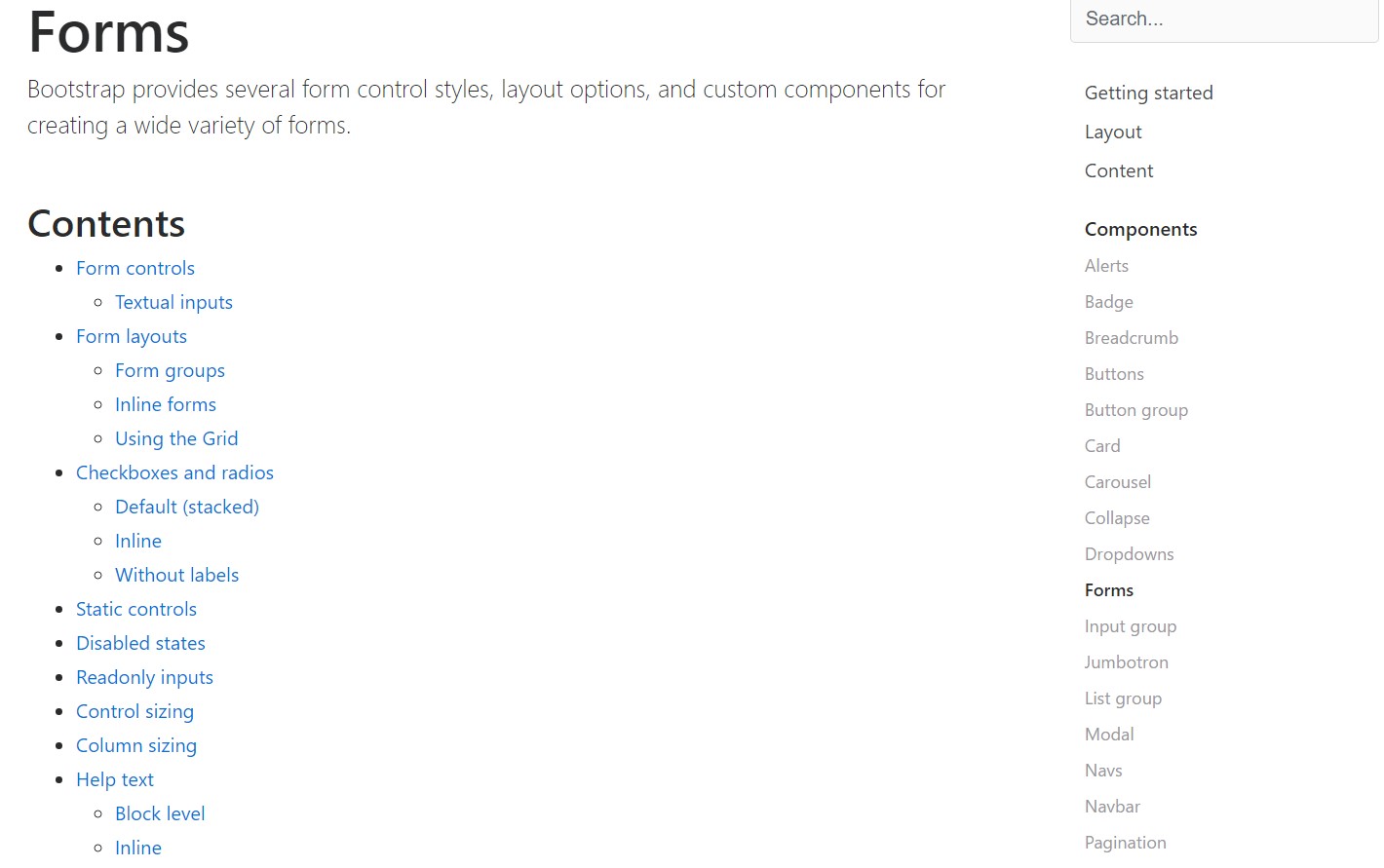
Bootstrap tutorial
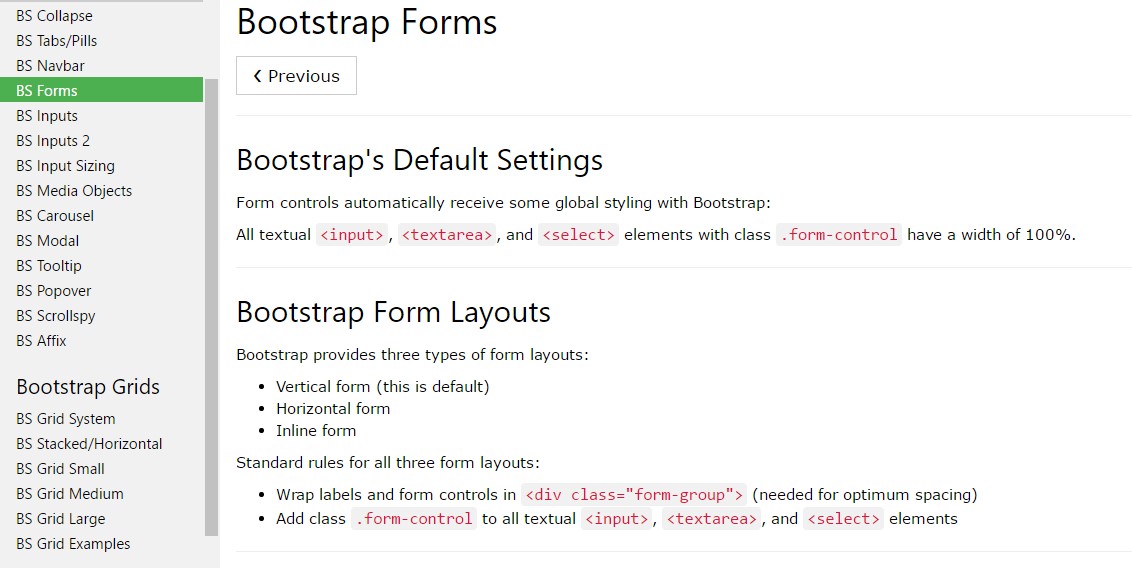
Support for Bootstrap Forms
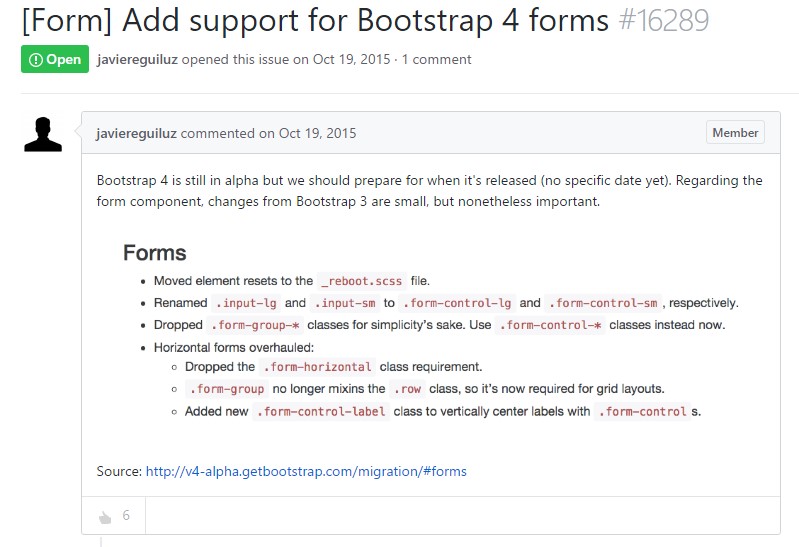
Why do not we check AMP project and AMP-form component?
